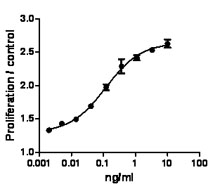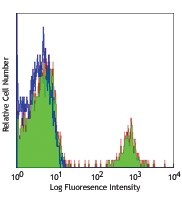- Regulatory Status
- RUO
- Other Names
- IL-17A, IL-2, IL-4, IL-10, IL-6, TNF-α, Fas, FasL, IFN-γ, Granzyme A, Granzyme B, Perforin, Granulysin
- Ave. Rating
- Submit a Review
- Product Citations
- publications
CD8 cytotoxic lymphocytes and Natural Killer (NK) cells play important roles in the host defense. CD8+ T and NK cells produce cytokines and utilize Fas/FasL, granzymes, perforin, and granulysin to eradicate tumor cells, virus-infected cells, and intracellular pathogens. Accurate measurement of the expression of these biomarkers is critical for in-depth understanding of the immune responses and many disease processes.
The LEGENDplex™ Human CD8/NK Panel is a bead-based multiplex assay, utilizing fluorescence–encoded beads intended for use on various flow cytometers. This panel allows simultaneous quantification of 13 human proteins, including IL-2, IL-4, IL-6, IL-10, IL-17A, IFN-γ, TNF-α, soluble Fas, soluble FasL, Granzyme A, Granzyme B, Perforin, and Granulysin. This panel provides high sensitivities and broad dynamic range. The panel has been validated for use on serum, plasma and cell culture supernatant samples.
Kit Contents
- Kit Contents
-
- Setup Beads: PE Beads
- Setup Beads: Raw Beads
- Human CD8/NK Panel Premixed Beads V02
- Human CD8/NK Detection Abs V02
- Human CD8/NK Panel Standard, Lyophilized V02
- SA-PE
- Matrix D4, Lyophilized
- Assay Buffer
- Wash Buffer
- Filter Plate
- Plate Sealers
Product Details
- Verified Reactivity
- Human
- Application
-
Multiplex - Panel
Learn more about LEGENDplex™ at biolegend.com/legendplex
Download the LEGENDplex™ software here. - Materials Not Included
-
- Flow Cytometer
- Pipettes and Tips
- Reagent Reservoirs for Multichannel Pipettes
- Polypropylene Microfuge Tubes
- Vortex Mixer
- Sonicator
- Aluminum Foil
- Absorbent Pads or Paper Towels
- Plate Shaker
- Tabletop Centrifuges
- A Vacuum Filtration Unit and a Vacuum Source
- 1.1 mL polypropylene micro FACS tubes, in 96-tube rack
Antigen Details
- Gene ID
- 3605 View all products for this Gene ID 3569 View all products for this Gene ID 7124 View all products for this Gene ID 355 View all products for this Gene ID 356 View all products for this Gene ID 3458 View all products for this Gene ID 3002 View all products for this Gene ID 3558 View all products for this Gene ID 3566 View all products for this Gene ID 3587 View all products for this Gene ID 3001 View all products for this Gene ID 5551 View all products for this Gene ID 10578 View all products for this Gene ID
Related Pages & Pathways
Pages
Related FAQs
- If I don't have a vacuum, how do I remove the liquid from my plate?
-
If you do not have a vacuum, the assay should be run in a V-bottom plate. After centrifugation using a swinging-bucket rotor with a plate adaptor, you can remove the liquid by flicking the plate quickly, dumping the contents into a sink, and patting it dry carefully on a stack of clean paper towels without losing the beads. Alternatively, you can remove the liquid by using a pipette.
- Should I perform the assay with the filter plates or with V-bottom plates?
-
Filter plates or V-bottom plates have been included in some kits for your convenience. A vacuum filtration unit is required to work with the filter plates. However, if you don’t have access to a vacuum manifold or if you prefer, then you can use the V-bottom plates and follow the recommended assay protocols for the type of plates you choose. All plates should be made from low binding polypropylene. Polystyrene ELISA or cell culture plates should not be used.
- After I finish the staining process, how long can I wait before reading my LEGENDplex™ samples?
-
The samples can be kept overnight at 4°C while being protected from exposure to light and be read the next day. There may be a decrease in signal, but overall, the assay results should not be affected. Storing the samples for extended periods of time is not recommended, as it could lead to further reductions in signal.
- What is the shelf life of LEGENDplex™ kits?
-
LEGENDplex™ kits are guaranteed for 6 months from the date of receipt, but may have a shelf life of up to 2 years from the date of manufacture.
- Is special software required for data analysis?
-
Typically flow cytometers generate output files in FCS format (e.g. FCS 2.0, 3.0, or 3.1) and in some cases in list mode file format (LMD). Other software may be available to analyze FCS files. Data generated using LEGENDplex™ kits can be analyzed using the freely available LEGENDplex™ data analysis software. Please check our website for the most updated versions of the software.

 Login / Register
Login / Register 













Follow Us